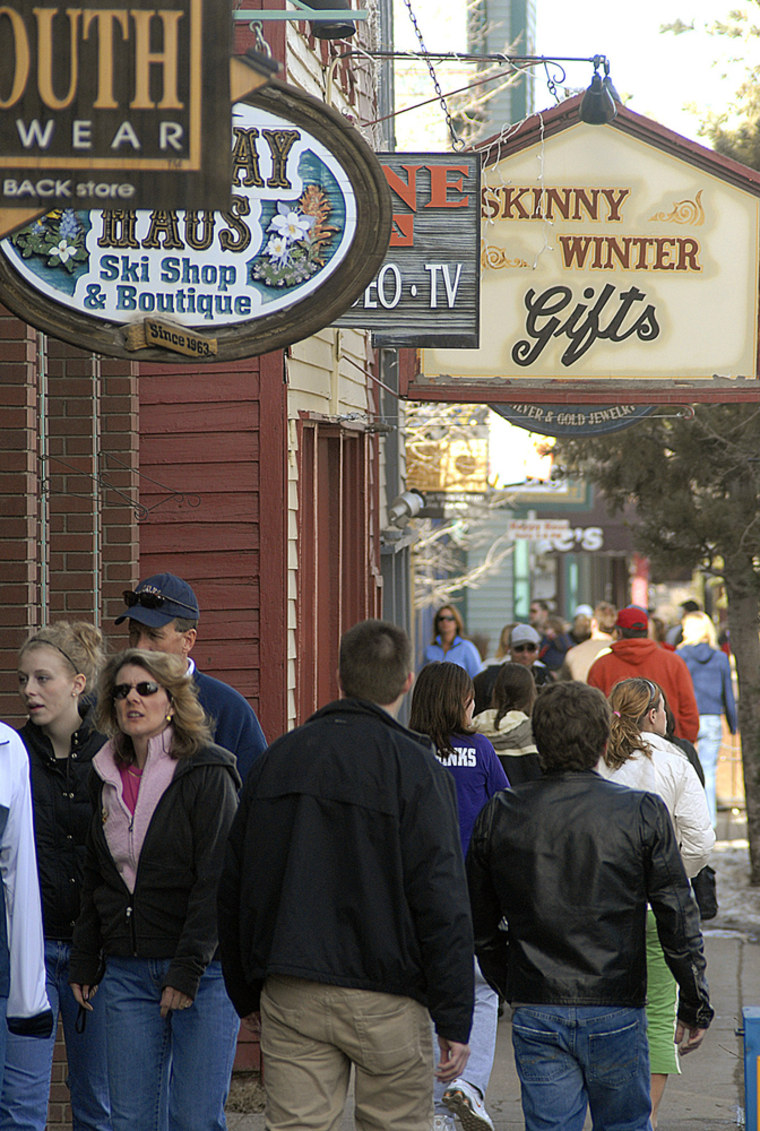In the ski town of Breckenridge, the holiday rush is for the slopes, not the shops. Residents can buy a Christmas tree, upscale clothing, boots or trendy cookware but will be hard-pressed to find an iPod along Main Street. Thing is, residents in the quaint Victorian-style resort about 100 miles west of Denver like it that way.
"It's nice being in a place where there are no chains (stores)," said Elisabeth Gallup, 28, who opened her Cookin' Cowgirl shop on Breckenridge's Main Street about three years ago.
It's a familiar refrain in resort communities around the West, which love to cash in on visitors but don't want to surrender the small-town feel they believe contributes to their bottom lines. Big box retailers have passed on many resort towns because of local opposition or because land is too scarce or expensive. Some towns have considered local measures to keep them out, fearing they would detract from the character.
"I don't feel like we're really on the outskirts or super isolated," says store owner Trinidad Carreon of Whitefish, Mont., a ski resort town near Glacier National Park. "We can pretty much meet our needs."
Resort retailers cater to tourists during the busy ski season, which starts around Thanksgiving for Colorado resorts and ends in late March — and during the summer, when visitors enjoy hiking, fishing, golfing and outdoor activities.
The stores also serve year-round residents and, in a growing number of cases, are finding new customers among second-home owners.
"The thing that changes for us being in a resort is that the day after Christmas in the city you've peaked and it's all sort of going downhill," said John Balma, 57, who opened a clothing store called Goods in Breckenridge in 1974.
"In January, it's just like you could bowl through the stores whereas for us, it just kind of keeps going solid all the way through Easter," said Balma, whose store originally sold work clothes and jeans to year-round residents but has shifted to upscale, fashionable apparel.
Although he describes Breckenridge as a great boutique town, Balma admits he is tempted to travel to Denver to shop for electronics bargains.
"If you're a consumer trying to buy a new faucet for your house or something then you kind of miss The Home Depot," he said. "People are kind of torn between the convenience of some of those kind of stores or just not really wanting to be like that."
Breckenridge is tucked in a 9,600-foot valley about 15 miles from a major interstate along a highway that winds through thick stands of forest. Founded in 1859 during the gold rush, the town of about 3,000 year-round residents today stretches seven miles long and two miles wide.
It has an average of 180 shops and a small retail district along Main Street just below Breckenridge Ski Resort, one of the largest in North America.
There are no nationwide chain retail stores, though Wal-Mart is about nine miles down the road in Frisco and Target is a bit farther away in Silverthorne, a 20-minute drive on a clear-weather day.
There are a couple of restaurant chains — including the requisite Starbucks — and a chain grocery store. For the most part, thought, Breckenridge is marked by individually owned boutiques specializing in clothing, ski equipment and apparel, T-shirts, gifts and galleries, including some that pay homage to the city's western history.
Whitefish, a community of about 7,000 near the Big Mountain Ski Resort, is similar to Breckenridge in that the stores are primarily individually owned stores. There are big-box retailers in nearby Kalispell.
"It's a ski resort town that is a small town. We're not like an Aspen. We're not there, nor do the people really want that," said Carreon, whose Back Door General Store features locally made gifts and crafts.
Carreon, who moved to Montana from California, said he has a clientele of about 60 percent visitors and 40 percent year-round residents.
"If we really concentrate on the locals, the visitors really kind of take care of themselves, meaning they are going to come in," he said.
In Taos, N.M., a resort town of about 5,000 that blends a vibrant arts community with a ski area and outdoor activities, retail stores are again mostly locally owned.
"Big boxes are kind of the antithesis of what the community is all about here," said Brian Chew, a 50-year-old self-professed corporate refugee from Boston who owns Taos Mountain Electronics. "It doesn't fit with the local economy, the local environment or the look and feel of Taos."
Chew's business, which features products from digital cameras and computers to high-end home-theater systems, primarily serves year-round residents and second-home owners with a smaller tourist trade.
"Supplies are difficult. It's almost like being on an island because everything has to be shipped here so the prices are naturally a little bit higher," he said, though he doesn't regret his move to Taos where he can bike, ski, cycle and enjoy the outdoors.
Steamboat Springs, a resort town 160 miles northwest of Denver, carries the nickname of Ski Town USA. Some merchants are working to preserve the historic downtown area and, at the same time, trying to coexist with national chain stores, said Tracy Barnett, who heads the Main Street-Steamboat Springs program.
"What we're looking for is to change our mix so we can stop the leakage, the people that leave Steamboat to go shop on the Internet or shop anywhere else," she said. "If they can't get it here they're going to have to go somewhere else.
"What we don't want to lose is the character. It doesn't necessarily have to stay small to maintain the character."
